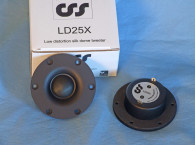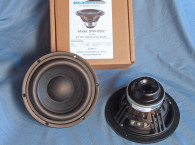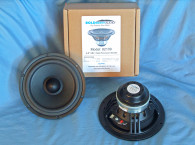
The CSS SDx10’s most distinguishing feature is its XBL^2 motor technology, which CSS licenses from inventor Dan Wiggins for two of its woofers — the SDx10 and the LD25X tweeter, which was featured in Voice Coil’s July 2020 issue. Like the Mmag patented dual-gap dual magnet motor technology developed by Enrique Stiles and Patrick Turnmire, the XBL^2 motor features a short voice coil traveling between two gaps. While Mmag uses two magnets and two plates, XBL^2 creates two gaps by using a thick front plate with a CNC’d groove in the middle of the plate to form the dual-gap structure. Whichever dual gap technology is used, it results in a typically shorter voice coil that travels into the second gap as it is traveling out of the first gap — the upshot being a higher Xmax than most conventional motors can provide.
Besides the XBL^2 motor, the CSS SDx10 has a well-appointed feature set that includes a proprietary cast 12-spoke (6 twin spokes) cast-aluminum frame that has minimal reflection surfaces and is vented below the spider mounting shelf. This includes 18 8mm × 4mm outlets and six 10mm × 7mm outlets. Additional convection cooling is provided by a 30mm diameter pole vent. The frame also has a rubber trim ring for mounting.
Other features include the incorporation of a very stiff coated black paper/carbon fiber blended composite cone, further stiffened by a 4.3” convex black hard paper dust cap. Suspension is provided by a NBR surround, plus 5.5” diameter semi-progressive cloth spider (damper). All this is driven by a 60.6mm diameter (2.4”) six-layer voice coil wound with round copper wire on a non-conducting former (rated power handling is 750W RMS).
The motor structure powering the cone assembly utilizes two 12mm thick 149mm diameter ferrite magnet sandwiched between a black plated 14mm thick XBL configured front plate and a black-plated 10mm thick T-yoke. The motor assembly also includes two aluminum shorting ring (Faraday shield) that reduces distortion caused by eddy currents. Last, the braided voice coil lead wires terminate to a plastic terminal block that incorporates two color-coded chrome binding posts.





I began characterizing the CSS SDx10 using the LinearX LMS analyzer and VIBox to measure both voltage and admittance (current). Sweeps were generated in free-air at 0.3, 1, 3, 6, 10, 15, 20, and 30V. It should also be noted that this multi-voltage parameter test procedure includes heating the voice coil between sweeps for progressively longer periods to simulate operating temperatures at that voltage level (raising the temperature to the first and second time constants). I further processed the 16 sine wave sweeps for each woofer with the voltage curves divided by the current curves to produce impedance curves.
I generated phase curves using the LEAP phase calculation routine, after which I copy/pasted the impedance magnitude and phase curves plus the associated voltage curves into the LEAP 5 Enclosure Shop software’s Guide Curve library.
I used this data to calculate parameters using the LEAP 5 LTD transducer model. Because most manufacturing data is being produced using either a standard transducer model or in many cases the LEAP 4 TSL model, I also generated LEAP 4 TSL model parameters using the 1 V free-air that can also be compared with the manufacturers data. Figure 1 shows the 1V free-air impedance plot. Table 1 compares the LEAP 5 LTD and LEAP 4 TSL Thiele-Small (T-S) parameter sets for the two CSS SDx10 driver samples along with the CSS factory data.
From the comparative data shown in Table 1, you can see that all four parameter sets for the two samples were reasonably similar and correlated well with the factory data. Following my normal protocol for Test Bench testing, I used the Sample 1 LEAP 5 LTD parameters and set up two computer box simulations—one in a 1.46 ft3 Butterworth type sealed enclosure with 50% fill material (fiberglass); and for the second example, a Chebychev /Butterworth-vented alignment in a 2.4 ft3 box with 15% fill material and tuned to 22 Hz.
Figure 2 gives the results for the SDx10 in the sealed and vented enclosures at 2.83 V and at a voltage level high enough to increase cone excursion to Xmax + 15% (21.2mm for SDx10). This resulted in a F3 of 38Hz (-6dB = 33Hz) with a Qtc = 0.68 for the 1.46 ft3 closed box and a -3 dB for the vented simulation of 35Hz (-6dB = 30Hz). Increasing the voltage input to the simulations until the approximate Xmax +15% maximum linear cone excursion point was reached resulted in 113.5dB at 60V for the sealed enclosure simulation and 115.2dB with a 65V input level for the larger passive box. Figure 3 shows the 2.83V group delay curves. Figure 4 shows the 60V/65V excursion curves, respectively.



Klippel analysis for the CSS SDx10 produced the Klippel data graphs provided in Figures 5–8. Our analyzer is provided courtesy of Klippel GmbH, and the analysis was performed by Patrick Turnmire, owner of Redrock Acoustics and author of the SpeaD and RevSpeaD transducer simulation software. (Please note, if you do not own a Klippel analyzer and would like to generate this type of data on any transducer, Redrock Acoustics can provide Klippel analysis of most any driver. For contact information, visit www.redrockacoustics.com.)
The Bl(X) curve for SDx10 seen in Figure 5 is rather broad but with substantial asymmetrical behavior, so not exactly typical of a driver with a relatively high Xmax. The Bl symmetry curve in Figure 6 shows a 5.6mm Bl coil-out (forward) offset once you reach an area of reasonable certainty at 16 mm excursion.
Figure 7 and Figure 8 show the Kms(X) and Kms symmetry curves for the CSS subwoofer. The Kms stiffness of compliance curve shown in seen in Figure 7 is moderately symmetrical and somewhat tilted with a degree of rearward (coil-in) offset once the analyzer gets to a position of reasonable certainty.
The Kms symmetry range curve shown in Figure 8 exhibits a fairly minor 0.49mm coil-in (rearward) offset at a region of high certainty (12mm) that increases to 1.8mm by the 18.4mm physical Xmax of this subwoofer. Displacement limiting numbers calculated by the Klippel analyzer for the SDx10 using the subwoofer criteria for Bl was XBl at 70% (Bl dropping to 70% of its maximum value) equal to great than 18.1mm for the prescribed 20% distortion level (the criterion for subwoofers).


For the compliance, XC at 50% Cms minimum was only 17mm, which means that for the CSS subwoofer, the compliance is the more limiting factor for getting to the 20% distortion level. However, both numbers were not far from the 18.4mm physical Xmax of the driver, despite the asymmetrical Bl behavior.
Figure 9 gives the inductance curve Le(X) for this transducer. Motor inductance will typically increase in the rear direction from the zero rest position as the voice coil covers more of pole, which is what you see in the graph. However, like the Bl curve, the inductive swing is also asymmetrical with 0.78 mH from the rest point rearward and 0.22 mH from the rest point forward.
Generally speaking I do not provide SPL and time domain measurements on subwoofers, as their upper range is generally not greater than 100Hz to 200Hz. Instead, you can see the factory generated SPL curve in Figure 10, however, please note that this was a near-field measurement.


Next, I used the Listen, Inc. SoundCheck analyzer with AudioConnect hardware, SoundCheck 16 software, and the SoundCheck SM3 1/4” microphone (all courtesy of Listen, Inc.) to perform distortion analysis. For distortion measurements, I set the voltage level with the driver rigidly mounted in free-air and increased the voltage until it produced a 1m SPL of 94dB (16.6V), my SPL standard for home audio drivers. Note that this decibel number is dependent upon the spectral content of the driver.
Once the analyzer had been configure, I made the distortion measurement with the microphone placed nearfield about 10cm from the dust cap. This plot for the SDx10 is shown in Figure 11. As can be seen, this actually includes two plots — the top graph being the standard fundamental SPL curve with the second and third harmonic curves, and the bottom graph the second and third harmonic curves, plus the THD curve with an appropriate X-axis scale. Interpreting the subjective value of THD distortion curves is difficult and opinions vary considerably in the industry. However, looking at the relationship of the second to third harmonic distortion curves is of value.
The CSS SDx10 has excellent build quality and reasonable Thiele-Small parameter numbers. Other than addressing the Bl asymmetry revealed in the Klippel analysis, this is a well-constructed 10” woofer with a high level of excursion capability. For more information, visit the CSS website at www.css-audio.com. VC
This article was originally published in Voice Coil, November 2020







